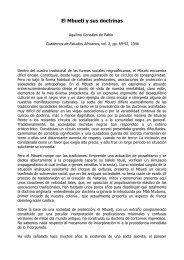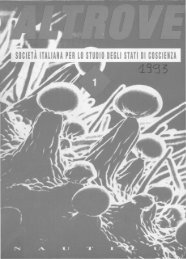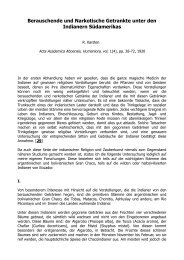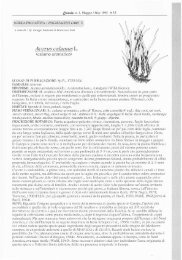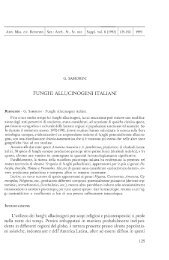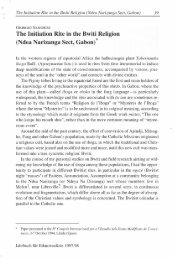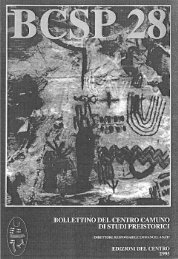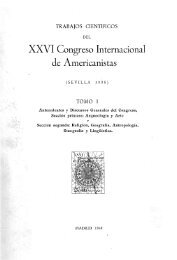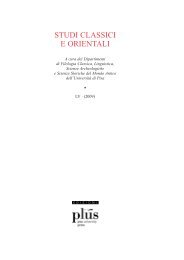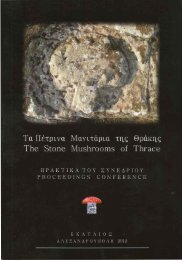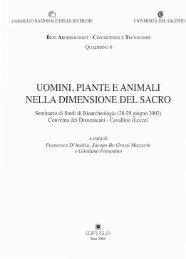Gli "alberi-fungo" nell'arte cristiana - Giorgio Samorini Network
Gli "alberi-fungo" nell'arte cristiana - Giorgio Samorini Network
Gli "alberi-fungo" nell'arte cristiana - Giorgio Samorini Network
You also want an ePaper? Increase the reach of your titles
YUMPU automatically turns print PDFs into web optimized ePapers that Google loves.
95<br />
GIORGIO SAMORINI Eleusis, n.s., n. 1, 1998<br />
lO, e ricordano gli <strong>alberi</strong>-fungo di Ounassia. Come questi<br />
ultimi, essi sono costituiti da tre funghi e sui "cappelli"<br />
sono disegnate delle striature.<br />
<strong>Gli</strong> studiosi chiamano questo tipo di vegetale "alberofungo",<br />
o anche "albero con la fronda a forma di medusa"<br />
(RIOU 1992) o anche li considerano "fiori a forma di funghi"<br />
(THOUMlEU 1997: 134). ELEMIRE ZOLLA (1979) non<br />
sembra avere perplessità circa l'intenzionalità di dipingere<br />
gli <strong>alberi</strong>-fungo di Saint-Savin-sur-Gartempe come veri e<br />
propri funghi allucinogeni, "simboli del divino e di poteri<br />
eccezionali".<br />
Come già sottolineato nel caso degli <strong>alberi</strong>-fungo del<br />
mosaico tunisino di Béja (fig. 7), le striature, che qui fuoriescono<br />
di un poco dalla "fronda", ricordano molto le<br />
ornamentazioni del bordo del cappello di alcune specie di<br />
Panaeolus. Le striature sono una<br />
caratteristica più fungina che arborea,<br />
presenti in moltissimi funghi,<br />
compresi quelli psicoattivi, poiché<br />
sono causate dalla giuntura della<br />
lamella con il cappello (si veda<br />
fig. Il). Le quattro ornamentazioni<br />
filamentose che si osservano<br />
sotto ogni cappello terminano con<br />
un piccolo oggetto rotondo, che<br />
potrebbe simboleggiare il frutto<br />
dell' albero-fungo.<br />
In fig. 12 è riportato il frontespizio<br />
di una edizione tedesca dei<br />
Cannina BUI'ana. Datato all 'inizio<br />
del XlII secolo, questo libro è<br />
attualmente conservato presso la<br />
Staatsbibliotek di Monaco. Nella<br />
pittura sono raffigurati differenti<br />
tipi di <strong>alberi</strong>, piuttosto fantasiosi,<br />
che originano tutti da una fonte<br />
comune, cioè l'ampio gruppo di<br />
forme artistiche che, a partire dai<br />
periodi ellenici, si sviluppò nel<br />
Mediterraneo (GRABAR &<br />
NORDENFALK 1958). Uno di questi<br />
Fig. 13 - Chiesa di Vie. <br />
Berry, Francia centrale<br />
ChI/l'eh o[ Vie, Berry.<br />
centrai France<br />
<strong>alberi</strong>,<br />
molto piccolo<br />
e<br />
sovrastato da un uccello, situato<br />
nella parte centrale del registro<br />
see two trees of two types (o ne, a mushroom tree) which<br />
are also Iike the ones on the righI. A third tree of the same<br />
kind is depicted elsewhere<br />
among the nave frescos next<br />
to the scene of Moses in the<br />
presence of the Pharaoh<br />
(Rrou 1992: 35). We should<br />
also bear in m.ind that the<br />
Sai nt -Savi n-s ur -Gartempe<br />
frescos include many other<br />
trees which also have a fairly<br />
tali trunk which is often<br />
above a sort of ring. The<br />
trunk spreads out to form a<br />
number of branches, gene-<br />
Fig. 12 - Frontespizio di un 'edizione tedesca dei Carmina<br />
Buran.a. XIU secolo d.C. (da G RABAR & N ORDENFALK 1958)<br />
Frontespiece o[a German edi/ion o[ /he Carmina BUl·ana.<br />
13/h C AD ([rom GRABAR & N ORDENFALK 1958)<br />
superiore, è un albero-fungo, del<br />
tipo di Saint-Savin, costituito da tre<br />
funghi e con le striature sui relativi<br />
cappelli.<br />
Stando alle affermazioni di<br />
Panofsky (in WASSON 1968:179)<br />
gli <strong>alberi</strong>-fungo sono numerosi nel<br />
l'arte romanica e nella prima arte<br />
Fig. I I - Panaeolus sp.<br />
rally three, and some branches<br />
terminate with a compact trilobate<br />
frond. A number of these<br />
trees spring from a small conical<br />
base or mound which might<br />
represent a mountain (RIOU<br />
1992). H has been suggested<br />
that the pictorial cycle of Saint<br />
Savi n-sur-Gartempe contai ns<br />
stylistic influences of the<br />
Byzantine art of northern Haly<br />
(cf. LABANDE-MAILFERT 1974).<br />
The mushroom-trees are all the<br />
same. They have a large trunk<br />
encroaching downwards upon<br />
the lower scenes of the same<br />
wall, as we may note in the<br />
detail provided (fig. lO). These<br />
trees are also similar to the<br />
Ouna')'ssia mushroom-trees.<br />
Here too, they present three<br />
mu shrooms with striated<br />
"caps".<br />
Scholars have termed this kind<br />
of vegetation " mushroomtree",<br />
or even "tree with medusa-shaped<br />
frond" (R10U 1992).<br />
Alternatively, it has been defined<br />
"mushroon-shaped<br />
flowers" (THOUMIEU 1997: 134). ELEMIRE ZOLLA (1979)<br />
seems to have no hesistation at ali as to the inspiration of<br />
the Saint-Savin-sur-Gartempe mushroom-trees: they are<br />
hallucinogenic mushrooms, "symbols of the divine, and of<br />
exceptional powers".<br />
As stated above, in reference to the mushroom-tree<br />
from the Béja mosaic (fig. 7), the striations hanging over<br />
the "frond" are very similar to the fringes on thecaps of<br />
various species of Panaeolus. These striations are more a<br />
feature of mushrooms than trees; very many mushrooms<br />
present these striations, some of which are psychoactive. In



